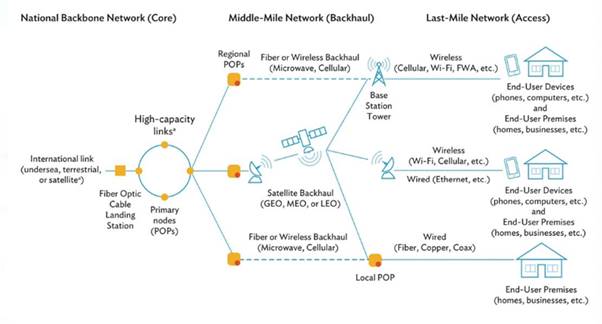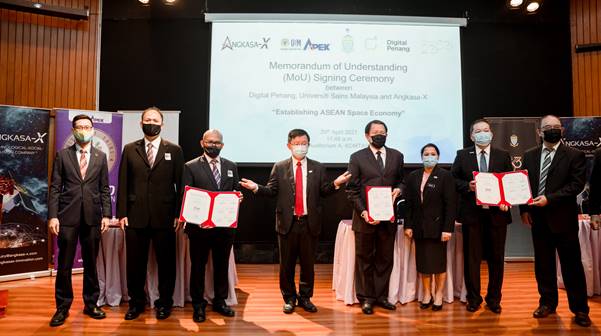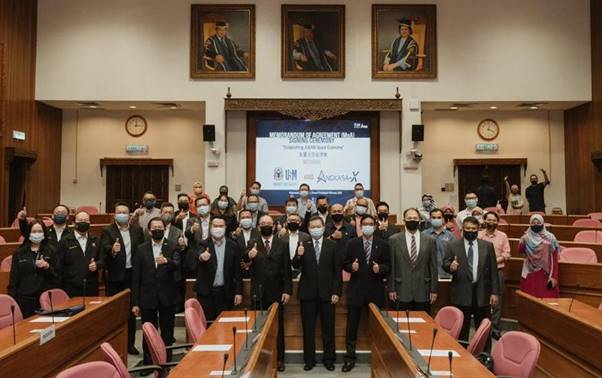KUALA LUMPUR, 19 May 2021: It’s literally a lofty vision, but the Angkasa-X Group of Companies have concrete plans to make Malaysia a regional space hub offering ‘Satellite-as-a-Service’ (SAAS), an advanced data sharing technology made available through satellites.
Its Executive Chairman and CEO Dr Sean Seah described the company as a ‘technological-social inclusion company’ committed to providing internet connectivity, particularly for the region’s underserved communities.
“Studies have shown that the more connected countries are to the information, communications and technology, the higher their GDP growth tends to be. As connections to information become more prevalent, such access will continues to drive economies, increase productivity and efficiencies – while also reducing poverty in underserved communities,” he said.
The total population among ASEAN countries as end- 2020 stands at over 668 million. Out of this huge population, approximately 335 million or 50% of people are living in the rural areas who have inadequate access to internet-connectivity. What’s more, there are some 30,000 islands throughout the Southeast Asian region, with most being deprived of internet connectivity.
“To realise SAAS aspirations, the Angkasa-X team is working hard to establish a dedicated space infrastructure provided in the form of a service model,” shared Sean.
“SAAS is very much a platform model – similar to Grab in our region, and AirBNB – in terms of renting out an entity. The benefit for governments and customers is that they now need not invest a huge amount of money to establish infrastructure, especially in remote areas where traditional terrestrial fibre network is limited, but would be able to tap on this service for a faction of the cost,” he added.
International and domestic partnerships for holistic space ecosystem
To achieve this goal, Angkasa-X has partnered with various entities to invest in Research & Development, intellectual property (IP) creation, components sourcing and testing, assembly and manufacturing, launching and maintaining state-of-the-art Low-Earth-Orbit (LEO) satellites.
“LEO satellites are essential components are our space infrastructure backbone. Our satellites are set to orbit close to the Equator and Angkasa-X has plans for a 500-satellite constellation to connect the Southeast Asian region in a conducive manner,” said Sean.
In the United States, the Washington Post has reported that billionaires Elon Musk and Jeff Bezos also aim to launch thousands of LEO satellites to circle the globe. Their plan is to offer high-end internet coverage for clients like governments, mining companies and shipping conglomerates, as well as providing it to regions too remote or poor to install it on the ground.
LEO satellites tend to operate from 500 kilometres to 2,000 kilometres above the earth’s surface.
Traditional communication satellites are stationed far higher, at roughly 36,000 kilometres, and travel in so-called geosynchronous orbits, moving at the speed of the earth’s rotation and appearing to float motionless above a fixed point.
Sean explained that, besides serving rural areas, its LEO satellite solutions could also be used for a wide variety purposes: from training the next generation of students to testing out new technologies in space, from atmospheric and climate research to ocean traffic monitoring.

Angkasa-X target customer base include government bodies, telecommunications companies, research institutes, universities, commercial enterprises together with non-governmental organisations (NGOs).
“What has worked in our favour is that satellite technologies have advanced, while costs is lower than before, and we believe that enough demand could be unlocked for us to truly transform the Malaysian and Southeast Asian regional landscape.”
Angkasa-X aims to launch its first LEO satellite sometime in 2022.
“Owning and operating space infrastructure involves having in-depth expertise, dedicated teams and intensive capital expenditure before results are tangible. Hence, Angkasa-X’s strategy is to create a wholesome and holistic ecosystem to realise this aspiration.”
Angkasa-X already has a very strong Satellite Design and Engineering Team. “A few of them are professors. Our team leads are currently working on LEO satellite projects abroad,” shared Sean.
Through a collaboration with Universiti Sains Malaysia (USM), the global education technology partners to bring ‘satellite design and engineering’ courses for talent development, while also training up its design and engineering team in Malaysia, include SPUTNIX. The company is ranked 6th in the “Fast Growing” category and 10th in the “Most Innovative” category among all Russian high-tech companies according to the TechUspech annual rating, and the first company to launch a private Russian satellite in 2014.
In Malaysia, Angkasa-X had last month signed a three-party Memorandum of Understanding (MOU) with the Penang State Government and University Science of Malaysia (USM) to establish the ASEAN Space Economy by forming the ASEAN-LINK satellite constellation.

In addition, the company also signed a Memorandum of Agreement (MOA) with USM for the Space Technology and Satellite Engineering Talent Development Programme. The aim of this programme is to develop more skilled talent for the space industry, with Angkasa-X also having establish its Space Technology Education Fund to provide the necessary funding to train up graduates from universities to join its ASEAN-LINK satellites constellation programme.
Sean also shared that Angkasa-X is deeply involved with Malaysia’s electrical and electronic (E&E) industry, particularly in Penang.
“A number of E&E players have decided to partner with us and we are also working hard to further firm up the component supply chain,” he said.

The financing aspect
On the funding side, with the support of its strategic equity partners Greenpro Capital Corp. (NASDAQ: GRNQ) and SEATech Ventures Corp. (OTC PINK: SEAV), Angkasa-X plans to offer an initial public offering (IPO) in the U.S. capital markets in forthcoming months.
“The Morgan Stanley Space Team estimates that the roughly US$350 billion global space industry could surge to over US$1 trillion by 2040. We aim to bring a slice of this pie to Malaysia for the benefit of ASEAN countries,” said Sean.
“At the end of the day, though, what we are truly aiming for is the establishment of the ASEAN Space Economy to provide affordable internet-connectivity as a necessity.
“The bigger picture is about social inclusion and digital economic transformation to rural communities within ASEAN countries while delivering a number of sustainable development goals laid out by the United Nations,” added Sean, who is also PIKOM (National Tech Association of Malaysia) Deputy Chairman.
“We believe that, at the rate we are moving, Angkasa-X will be Malaysia’s first ‘unicorn’ (tech company valued at over US$1 billion) and the number one go-to company for LEO satellite-based Internet services in ASEAN.”
Earlier this year, Sean was also appointed Deputy Chairman of the World Information Technology & Services Alliance (WITSA) and re-elected as Chairman of the WITSA Finance Committee for the 2020-2022 term.
In 2022, Malaysia will be hosting the World Congress on IT (WCIT) in 2022 – billed as the ‘Olympics of the ICT world’ – and Sean will be continue to be instrumental in bridging and representing Malaysia to the global ICT industry.
Source: Angkasa-X Group
For more information, please visit Angkasa-X’s website, or LinkedIn.
Interested in having your announcements on Malaysiakini? Contact the announcements team at [email protected] or WhatsApp on +60 17-323 0707 for urgent matters.

